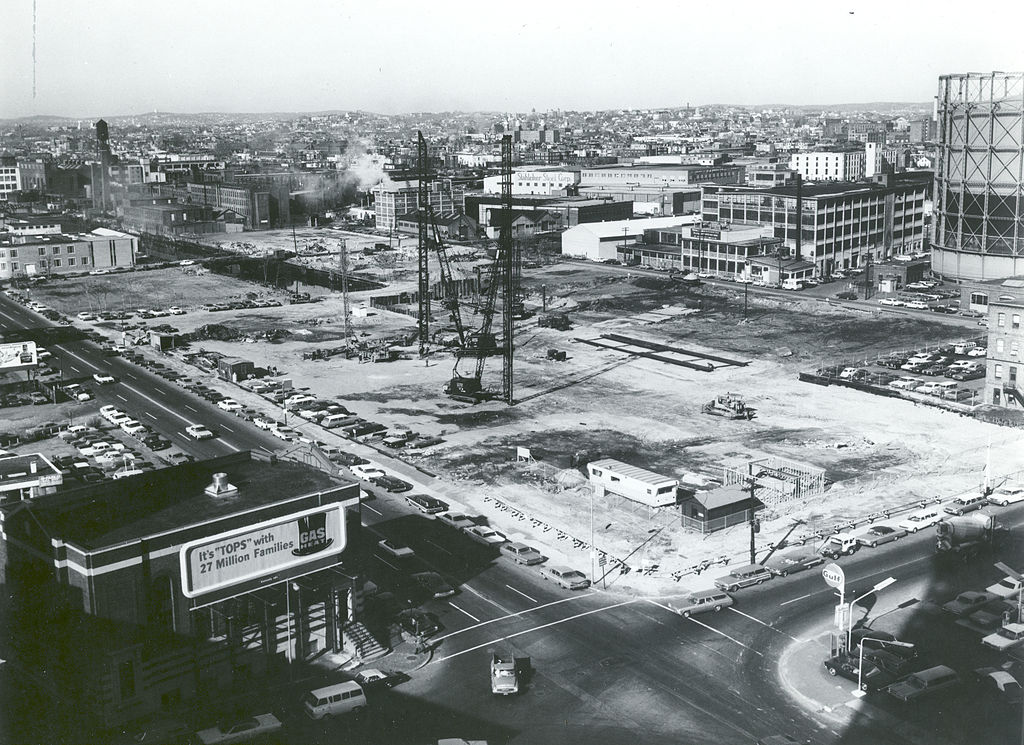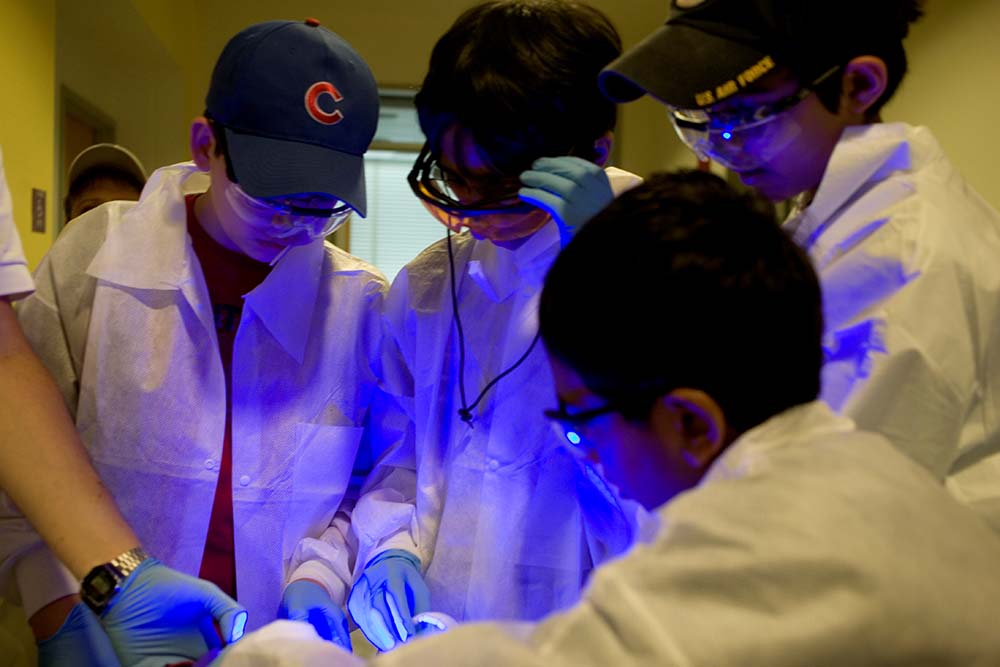The Cambridge Factor
MIT would be a very different institution had its campus been based anywhere but Cambridge. This extraordinarily diverse community has been home to some of the world’s great writers, scholars, scientists, musicians, artists, and revolutionaries, and the city celebrates them all. MIT and Cambridge have forged many productive collaborations over the last century—and both are richer as a result.
Choosing Cambridge
MIT’s 45 years in Back Bay were fraught with challenges. The neighborhood was becoming increasingly tony, and real estate was scarce and expensive. Lacking the space for dormitories, MIT was a commuter campus, lending to the struggle of proving that it was as complete an educational institution as its contemporaries. The existing campus structures were scattered across the neighborhood, and although they were buildings of some architectural distinction, the neighbors did not appreciate their lack of grandeur.
When new president Richard Cockburn Maclaurin took the reins in 1909, he immediately set about finding a way to move the campus to a location where the school could spread its wings. When a 50-acre span of new land along the Charles River came available, Maclaurin—resisting a series of overtures from Harvard to merge—worked tirelessly to raise the funds. George Eastman, founder of Eastman Kodak, donated the bulk of the funds under the pseudonym Mr. Smith and established a challenge for the remaining moneys, which Maclaurin raised. The outsized effort left him a spent man, however, and in 1920, at the age of 49, he succumbed to pneumonia. In its obituary, the New York Times described Maclaurin as “an uncommonly brilliant and versatile man.”
More
-
MIT Museum, “Sacrificing for Science: Death Mask of MIT President Richard C. Maclaurin,” MIT 150/Uniquely MIT
-
“Richard Cockburn Maclaurin, 1870-1920,” History of the Office of the MIT President, Institute Archives, MIT Libraries, October 2004
Kendall Square
In the late 18th century, the new West Boston Bridge (later replaced by the Longfellow Bridge) connected Boston to Cambridge in Kendall Square. What had been a marshy no-man’s land now began to burgeon with distilleries, power plants, and factories. The new MBTA—the first subway system in the nation—opened a station at Kendall in 1912. And when MIT moved into the neighborhood soon after, alumni companies began to dot the landscape. US President John Kennedy even pegged Kendall Square for the headquarters of NASA. Unfortunately, the dream died with him and the buildings purchased for that undertaking gradually deteriorated; so did Kendall Square.
By 2000, however, tech companies were spinning out of MIT at a prodigious rate and setting up shop in Kendall Square. Drawn to what’s been called the “most innovative mile on earth,” Apple, Microsoft, Google, Facebook, and Amazon joined them. Since 2010, MIT has been working with municipal leaders to make Kendall Square a vibrant urban hub to serve the sophisticated global constituency it now attracts. Although still in transition, Kendall Square has already metamorphosed into a bustling urban center with restaurants, hotels, and greenspaces. You can even rent a kayak at the new riverfront park.
More
-
Read more about the history and transformation of Kendall Square
-
Michael Blanding, “The Past and Future of Kendall Square,” Technology Review (August 18, 2015)

Aerial view of the foundation construction for NASA's Electronics Research Center (ERC) at Kendall Square in Cambridge, Massachusetts. The Center opened in September 1964 and has the particular distinction of being the only NASA Center to close, shutting down in June 1970. More information
Photo: NASA (Great Images in NASA Description) [Public domain], via Wikimedia Commons
Community Compact for a Sustainable Future
Over the years, MIT, Harvard, and the City of Cambridge have come to recognize that together they constitute a pretty formidable brain trust. What if they were to pool their resources and ingenuity? They could tackle some of the great problems facing humanity. The trio set about sharing best practices for improving the energy efficiency of campus operations, expanded the Hubway bike-sharing program, and created public greenspaces.
Energized by these successes and by the work they have been doing together to investigate—and mitigate—the effects of climate change in Cambridge, the partners resolved in 2013 to formalize that work with the Community Compact for a Sustainable Future. Under the compact, they have pledged to leverage their intellectual and entrepreneurial resources to create a healthier, more livable, more sustainable future. The three partners have been joined in their mission by several area corporations, including Akamai, Novartis, Boston Properties, and Whole Foods.
More
Smoots
The City of Cambridge has long rolled with—and even supported—harmless MIT hacks and pranks. There is no better example of this good-natured tolerance than its approach to the Smoot. In the fall of 1958, MIT fraternity Lambda Chi Alpha used freshman pledge Oliver Smoot (5’ 7” in his stocking feet) as a unit of measure across the 2,165-ft Harvard Bridge, the longest bridge connecting Cambridge to Boston. With bright indelible paint, the frat brothers marked off the entire length of the bridge every 10 Smoots, ultimately determining the bridge’s length to be “364.4 plus or minus one ear.”
Over the ensuing decades, Cambridge Police have relied on the Smoot markings to record locations in police reports and when the surface of the bridge was replaced, the city asked the fraternity to help maintain the Smoot markings. Bridge renovators even went so far as to score the concrete sidewalk at 5’7” intervals, rather than the standard six feet. Google now recognizes the Smoot as an official unit of measure and includes it as an optional unit of measure on Google Earth and in Google Maps. One note about Oliver Smoot: after graduating from MIT in 1962, he went on to become chair of the American National Standards Institute and president of the International Organization for Standardization.
More

Photo: AboveSummit with Christopher Harting
Recombinant DNA
In the 1960s and 1970s, nuclear weapons and environmental disasters had given the populace a sense that the scientific community should not be left to its own devices. One of the brightest red flags was the subject of recombining DNA (rDNA). In 1973, scientists proved that genetically engineered DNA molecules from one living organism could serve as a carrier for genes from an entirely different organism. The discovery opened up thrilling possibilities. Could healthy genes be transplanted into sick people? On the flip side, would cows be giving birth to chickens?
In 1975, MIT professor David Baltimore, (later president of Cal Tech) was awarded the Nobel Prize for genetic research. Although Baltimore and his colleagues had not been engaging in rDNA research, Cambridge Mayor Alfred Vellucci could see the writing on the wall. He decided to convene a public forum about whether to permit rDNA experiments within city limits. The city invited MIT experts to demystify rDNA research, which they did, week after week. After more than two months of high-profile exploration and debate in 1976, Cambridge passed the nation’s first law regulating rDNA research. Cautious but not limiting, the regulations fit MIT’s own judicious approach, so genetic research continued unimpeded.
More
-
John Durant, “‘Refrain from Using the Alphabet’: How Community Outreach Catalyzed the Life Sciences at MIT,” Becoming MIT: Moments of Decision, ed. David Kaiser (Cambridge: MIT Press, 2010)
STEM Outreach
MIT faculty and students see Cambridge as a living laboratory—a laboratory for testing theories about urban living, for sharing solutions, and for delivering impact on a very human scale. The Office of Engineering Outreach Programs (OEOP) has been providing lively science and engineering experiences to local middle and high school students since 1975. The idea is to engage and mentor students who are intimidated by science, technology, engineering, and math (STEM).
OEOP students and faculty have worked with more than 3,000 middle and high school students over the last four decades. In a recent year, 60 to 70 percent of the students participating in OEOP programs were from low socioeconomic backgrounds; 70 to 80 percent were underrepresented minorities. But OEOP has an even broader agenda—to demystify higher education in general and give these students a robust connection to a college-educated future. In addition to their STEM activities, OEOP students attend seminars from college admissions and industry professionals. Many OEOP alumni have gone on to become influential leaders, innovators, and entrepreneurs.
More



